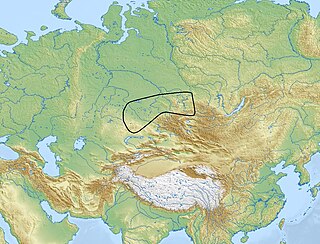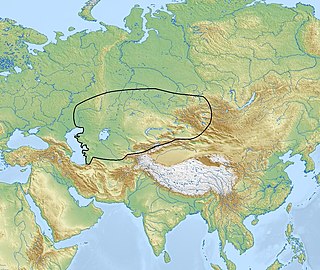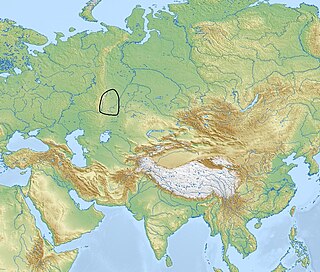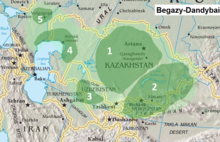
A kurgan is a type of tumulus constructed over a grave, often characterized by containing a single human body along with grave vessels, weapons and horses. Originally in use on the Pontic–Caspian steppe, kurgans spread into much of Central Asia and Eastern, Southeast, Western and Northern Europe during the 3rd millennium BC.

The Karasuk culture describes a group of late Bronze Age societies who ranged from the Aral Sea to the upper Yenisei in the east and south to the Altai Mountains and the Tian Shan in ca. 1500–800 BC.

The Andronovo culture is a collection of similar local Late Bronze Age cultures that flourished c. 2000–1150 BC, spanning from the southern Urals to the upper Yenisei River in central Siberia. Some researchers have preferred to term it an archaeological complex or archaeological horizon. The slightly older Sintashta culture, formerly included within the Andronovo culture, is now considered separately to Early Andronovo cultures. Andronovo culture's first stage could have begun at the end of the 3rd millennium BC, with cattle grazing, as natural fodder was by no means difficult to find in the pastures close to dwellings.

The Srubnaya culture, also known as Timber-grave culture, was a Late Bronze Age 1900–1200 BC culture in the eastern part of the Pontic–Caspian steppe. It is a successor of the Yamna culture, the Catacomb culture and the Poltavka culture. It is co-ordinate and probably closely related to the Andronovo culture, its eastern neighbor. Whether the Srubnaya culture originated in the east, west, or was a local development, is disputed among archaeologists.

Potapovka culture was a Bronze Age culture which flourished on the middle Volga in 2100—1800 BC.

Poltavka culture was an early to middle Bronze Age archaeological culture which flourished on the Volga-Ural steppe and the forest steppe in 2800—2100 BCE.

The Koban culture or Kuban culture, is a late Bronze Age and Iron Age culture of the northern and central Caucasus. It is preceded by the Colchian culture of the western Caucasus and the Kharachoi culture further east.
The Tagar culture was a Bronze Age Saka archeological culture which flourished between the 8th and 1st centuries BC in South Siberia. The culture was named after an island in the Yenisei River opposite Minusinsk. The civilization was one of the largest centres of bronze-smelting in ancient Eurasia.
The Glazkov culture, Glazkovo culture, or Glazkovskaya culture, was an archaeological culture in the Lake Baikal area during the Early Bronze Age.
Arzhan is a site of early Saka kurgan burials in the Tuva Republic, Russia, some 60 kilometers (40 mi) northwest of Kyzyl. It is on a high plateau traversed by the Uyuk River, a minor tributary of the Yenisei River, in the region of Tuva, 20 km to the southwest of the city of Turan.

The Mausolea of the Begazy–Dandybai culture are located in mountain valleys of Central Kazakhstan.
Okunev culture, sometimes also Okunevo culture, was a south Siberian archaeological culture of pastoralists of the early Bronze Age dated from the end of the 3rd millennium BC to the early of the 2nd millennium BC in the Minusinsk Basin on the middle and upper Yenisei. It was formed from the local Neolithic Siberian forest cultures, who also show evidence of admixture from Western Steppe Herders and pre-existing Ancient North Eurasians.

The Sintashta culture is a Middle Bronze Age archaeological culture of the Southern Urals, dated to the period c. 2200–1900 BCE. It is the first phase of the Sintashta–Petrovka complex, c. 2200–1750 BCE. The culture is named after the Sintashta archaeological site, in Chelyabinsk Oblast, Russia, and spreads through Orenburg Oblast, Bashkortostan, and Northern Kazakhstan. The Sintashta culture is thought to represent an eastward migration of peoples from the Corded Ware culture. It is widely regarded as the origin of the Indo-Iranian languages, whose speakers originally referred to themselves as the Arya. The earliest known chariots have been found in Sintashta burials, and the culture is considered a strong candidate for the origin of the technology, which spread throughout the Old World and played an important role in ancient warfare. Sintashta settlements are also remarkable for the intensity of copper mining and bronze metallurgy carried out there, which is unusual for a steppe culture. Among the main features of the Sintashta culture are high levels of militarism and extensive fortified settlements, of which 23 are known.
The Elunin culture or Elunino culture is an indigenous Bronze Age culture of animal breeders in the steppe and forest-steppe area of the Ob-Irtysh rivers of Ural foothill-plain zone in Siberia, developed from the local Bolshemys Eneolithic culture, dated around 2300–1700 BCE.

Irmen culture is an indigenous Late Bronze Age culture of animal breeders in the steppe and forest steppe area of the Ob river middle course, north of Altai in western Siberia, dated to around the 9th to 8th centuries BCE. Monuments of this advanced bronze-producing culture include numerous settlements and kurgan cemeteries, the culture was named after Irmen kurgan cemetery now flooded by Novosibirsk reservoir. Irmen culture was discovered and described by N.L.Chlenova in 1970.
The Tasmola culture was an early Iron Age culture during the Saka period in central Kazakhstan. The Tasmola culture was replaced by the Korgantas culture. They may correspond to the Issedones of ancient Greek sources.

The Tazabagyab culture is from late Bronze Age, ca. 1850 BC to 1500 BC, which flourished in lower Zeravshan valley, as well as along the lower Amu Darya towards the south shore of the Aral Sea; this last region is known as Khwarazm or Khorezm. Earlier it was thought to be from ca. 1500 BC to 1100 BC and regarded a southern offshoot of the Andronovo culture, composed of Indo-Iranians, but Stanislav Grigoriev, in a recent study asserts that Tazabagyab is not part of Andronovo culture.

The art of Kazakhstan covers all forms of art created throughout history by the peoples living on the territory of modern-day Kazakhstan. Throughout most periods, much of the population of Kazakhstan was nomadic, or at least moved regularly across the vast country. The great majority of the art of Kazakhstan is applied art: the decoration of practical objects, including household utensils and patterned harnesses, through art forms such as carpet-weaving, pottery, and leatherwork. The art of Kazakhstan also includes architecture, fine arts, and sculpture.
The Sauromatian culture was an Iron Age culture of horse nomads in the area of the lower Volga River to the southern Ural Mountain, in southern Russia, dated to the 6th to 4th centuries BCE. Archaeologically, the Sauromatian period itself is sometimes also called the "Blumenfeld period", and is followed by a transitional Late Sauromatian-Early Sarmatian period, also called the "Prokhorov period".

The Museum of Archaeology is an archaeological museum, part of the National Academy of Sciences of Kazakhstan, located in the Gylym Ordasy complex in Almaty, Kazakhstan.















